前田為康
堀越信司
高松佑圭
Maeda/Horikoshi/Takamatsu
For the Future of Parasports
Conditioning to Bring out the Best in Athletes
November 10, 2021
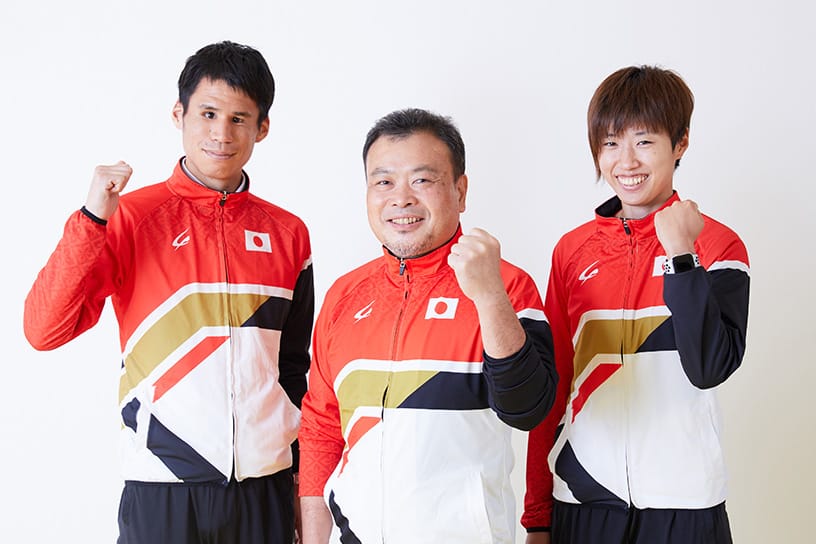
Photos: Asako Toda
First Encounter with Para Athletics
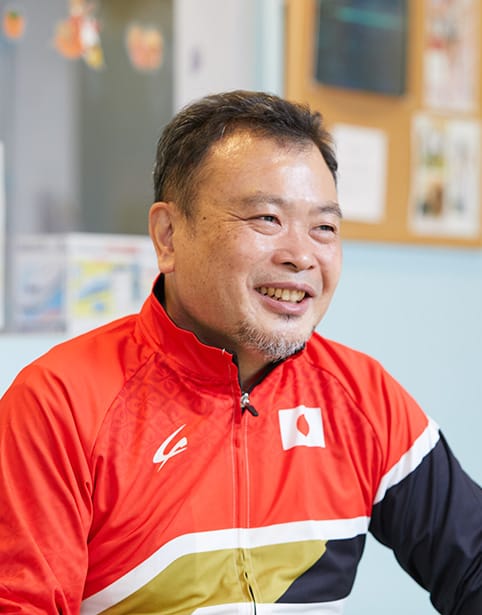
- ITO: First, I have a question for Mr. Maeda. How did you become involved in para athletics as a trainer?
-
Maeda: I started providing support in para athletics at the first Asian Para Games held in Guangzhou, China in 2010. At the time, I’d been dispatched by the Ski Association of Osaka to serve as an instructor for an Osaka City-run ski school for persons with disabilities. This led to an invitation to join them as a trainer from Mr. Tatsuhiko Yoshimura, Secretary-General of Japan Para Athletics.
After that, I joined the Trainer Subcommittee of the Strengthening Committee. I’ve been providing support in para athletics ever since.
- ITO: So your first encounter with parasports was with skiing.
-
Maeda: Yes. I’d been skiing competitively since I was a student, so I got certified as a basic ski instructor and helped out in various ways as a member of the Ski Association of Osaka. At that time, I heard there was a ski school for people with disabilities and that everyone was having fun skiing, so I thought I’d love to get involved. When I saw the joy on the faces of the people who hadn’t been able to ski beforehand, I was as happy as if it had been me. It was a really enjoyable and productive time.
- ITO: Were you also working as a trainer at that time?
-
Maeda: About 10 years after I started working as an instructor, I began bringing a bed and voluntarily provide care at night. I’m a trainer, an osteopath, and I really love treating injuries. [laughs] The students liked my treatment. I also worked as a trainer for the rugby team of the Osaka Prefectural Police and the baseball team of Osaka Toin High School at the time, so I heard the joyful voices of these athletes. I found myself enjoying treating them more and more.
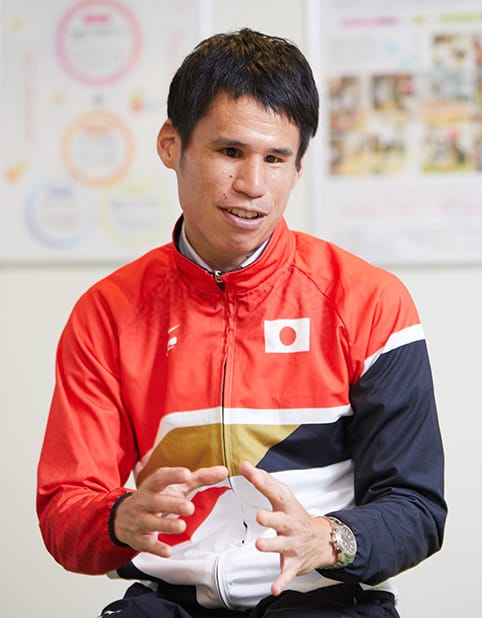
- ITO: What prompted you to get involved in athletics?
-
Horikoshi: I started doing athletics after entering junior high school. My parents encouraged me to pursue swimming when I was in elementary school, but when I left my parents to go to the Tsukuba University School for the Blind in Tokyo (now Tsukuba University Special Needs Education School for the Visually Impaired), I wanted to try another sport myself.
But there were just three sports clubs: swimming, athletics, and sound table tennis (table tennis for the visually impaired). I thought about what I should do, but when I was in elementary school, Maurice Greene (Sydney Olympics men’s 100 m gold medalist) was really popular, and Yuko Arimori (Barcelona Olympics women's marathon silver medalist / Atlanta Olympics women's marathon bronze medalist) and Naoko Takahashi (Sydney Olympics women's marathon gold medalist) had achieved great success, so I kind of drifted into the athletics club. [laughs]
- ITO: When did you start aiming for the world?
-
Horikoshi: During my three years in junior high school, I just continued to enjoy trying to improve my times. When I entered high school and started competing in the Japan Para Athletics Championships and Japan Para Championships, I never imagined I’d be able to compete on the world stage.
At university, I lived like a typical student, setting aside as much time as possible to training. In December 2007, during my first year at university, I ran the 1,500 m at the Tokai University Long Distance Competition and produced a pretty good time. I beat my personal best by about eight seconds. Eight seconds in the 1500 m is a big deal. So, I thought maybe if I worked hard one winter, I could participate in a tournament the following summer.
I got to participate in that competition, but I couldn’t get through the qualifier. I was really frustrated by that. I’d felt nervous, and before I knew it the race was over. I felt I was unable to show what I could do. I watched the final on TV and thought to myself, “I want to be able to compete with these guys.” That’s when I started aiming for the world.
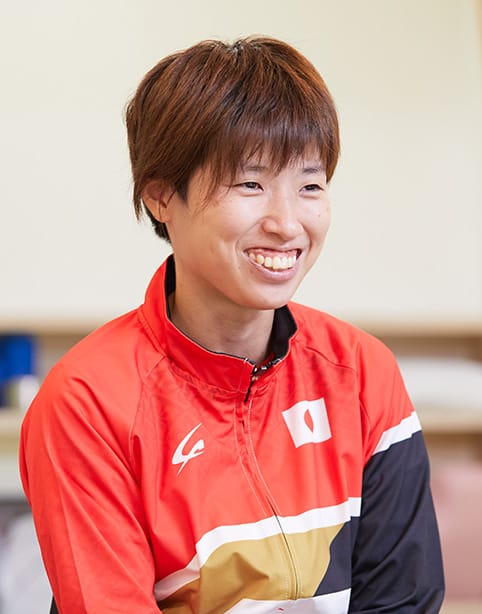
- ITO: How about you, Ms. Takamatsu?
-
Takamatsu: I was in junior school, but I hadn’t joined any of the clubs, so my mother said, “How about running?” I started athletics in the second year of junior high school. It was tough at first, but once my times started to improve, I started to enjoy it and kept going.
My high school didn’t have athletics clubs, so I played basketball for three years. But I resumed when I entered the workforce.
- ITO: Have you specialized in short distances since junior high?
-
Takamatsu: Yes, I’ve always run short distances. I don’t go over 400 meters. [laughs]
- ITO: [Laughs] So, which do you like better, the 100 m or the 400 m?
-
Takamatsu: Well, if I had to pick one, I’d say the 400, but I don’t like either of them. Training is so hard. [laughs]
[All laugh]
Making It Possible for the Athlete to Step up to the Starting Line in Their Best Condition
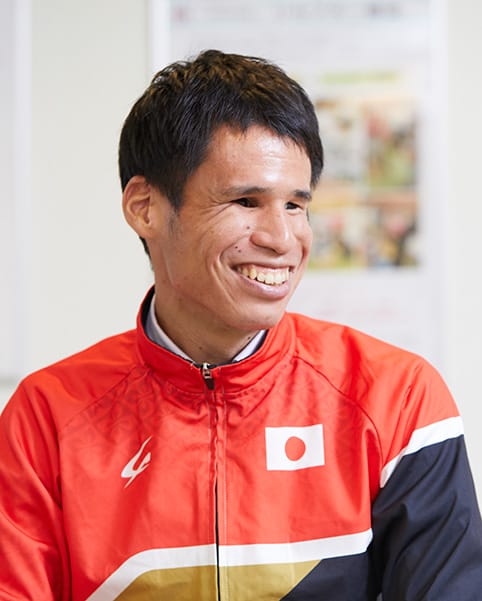
- ITO: I’ve heard you actually don’t mind running long distances at all. Do you run long distances when training, too?
-
Horikoshi: I do. Of course, there are limits, but I’ll run up to 50 km.
Takamatsu: 50 km! That’s not training anymore. [laughs]
Horikoshi: I guess not. [laughs] Though when I do it, I jog really slowly. When training, it’s important to control the quality and quantity, to strike just the right balance, so you don’t break down. That being said, if you only do that, you won’t get any stronger, so you have to push the envelope. I’m always trying push myself just hard enough, without overdoing it.
My body naturally responds to that, so I pay attention to my conditioning. When I met Mr. Maeda for the first time, I was still a university student, so I could get acupuncture once and feel better the next day, but that’s not the case anymore. [laughs]
I watch the changes in my body and in what areas fatigue tends to build up when I do this kind of training. When I feel like that, I wonder how and in what areas I should take care of myself so that I can get back to normal. I try to think about these things when I compete.
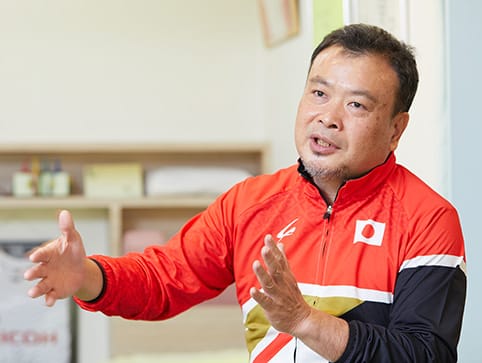
- ITO: What sort of things do you pay attention to when treating athletes?
-
Maeda: First, I try to assess the athlete’s condition as quickly as possible. For example, people talk about leg amputations in a non-specific way, but the muscles and joints used differ depending on whether the amputation was above or below the knee. And with visual impairments, levels and fields of vision vary from athlete to athlete.
To ensure these differences don’t affect the competition results, parasports are divided into different classes within each sport. That’s why it’s important to understand the characteristics of the athletes as soon as possible.Then it’s important to understand what the athletes want and to promptly respond to their needs. Each athlete has their own goals. I think the biggest role of a parasports trainer is finding out how far the athlete can go to achieve those goals and how to make the most of their remaining abilities and functionality.
- ITO: Identifying and drawing out potential isn’t something that can be done overnight, is it?
-
Maeda: No, definitely not. In my case, I think my experience of seeing people with various disabilities at the ski school I mentioned earlier has been significant. Thanks to that, when I became a para athletics trainer, I felt completely comfortable.
I’d developed an eye for certain things. For example, I knew that a wheelchair athlete would get very fatigued in their upper body and that differences in the scope of the paralysis would affect the force they could exert on their lower body and the performance they could achieve.
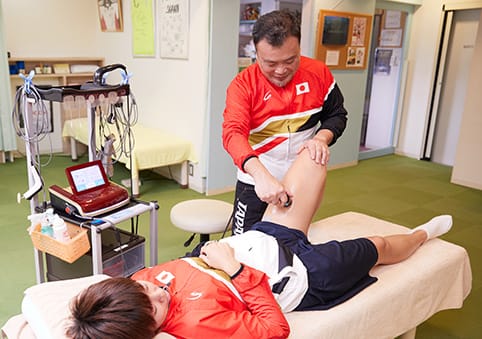
- ITO: You also use physiotherapy devices for treatment. How did that start?
-
Maeda: I’m the third generation at the Maeda Acupuncture and Osteopathy Clinic. When I was a child, my home and the clinic were in the same building, so I was always familiar with low-frequency and microwave treatment devices. I myself also suffered various injuries from skiing, and they took care of me when I was a student.
Later, when I started my career as a therapist, I worked in an orthopedic clinic and osteopathic clinic that were especially strong in the area of trauma. I learned about physiotherapy at those clinics.My main goal is to make the treatment time enjoyable and motivating and to enable the athlete to stand at the starting line in their best shape. To that end, mental support is also essential. I sometimes listen to the athletes’ concerns and give them advice.
Of course, the advantage of using physiotherapy is that it can relieve pain by targeting tissues like muscles, ligaments, and tendons and promote rapid improvement. But I think it also has great effects on athletes mentally. It’s like a psychological lucky charm that tells them: “You’re going to be okay because we’re using this device.”
- ITO: How about you two? What do you pay attention to in your conditioning?
-
Takamatsu: Avoiding overtraining and paying attention to sleep and nutrition. I also get treated regularly by Mr. Maeda at this clinic. When my calves get tight during practice, I use microcurrent for self-care.
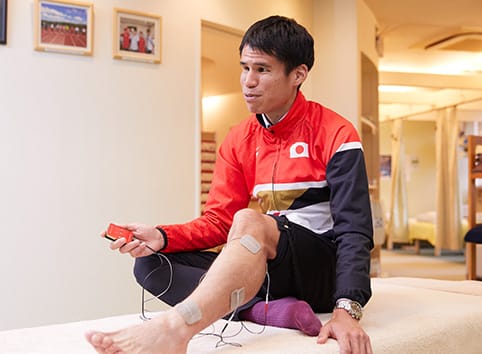
-
Horikoshi: I also do my best to avoid overtraining. But there are still times when I get injured. So when that happens, I focus on healing the injury as quickly as possible and getting myself into a state where I can practice without pain, with the help of various people, including Mr. Maeda.
I use ultrasound and electrical stimulation, and I’m careful to use them in a way that suits my physical condition. Machines are by no means a cure-all, so I only use them after carefully considering how best to use them, getting advice from people who actually use them, and trying them out on my own body.
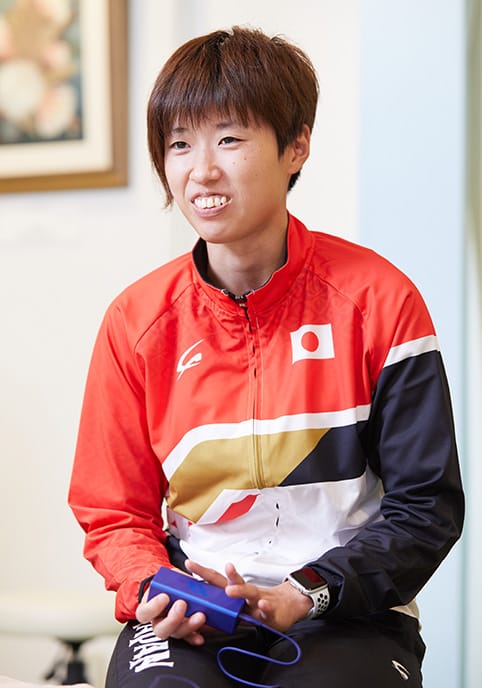
- ITO: Ms. Takamatsu, I hear you use RUCOE RUN for conditioning. How exactly do you use it?
-
Takamatsu: I often use it before going to bed. My favorite mode is Cool. I stick the pads on my calves to prepare for the next day.
How long should I use Cool?Maeda: 10 minutes at a strength that makes the muscles move comfortably. The timer switches it off after 10 minutes, but you can do two or three sets if you feel like it wasn’t enough.
Horikoshi: I haven’t tried it myself, but I’ve heard from athletes and guide runners. They said it applies a lot of stimulation. So perhaps I could use it before warming up. I’m thinking that if I apply gentle stimulation myself during the cold winter months, then go for a warmup, it might help prevent breakdowns.
Takamatsu: You really ought to try it.
Horikoshi: Okay then. Mr. Maeda, could you? [laughs]
Maeda: Since it’s after practice, I’ll put the pads on your calf and set it to Cool mode. You can adjust the strength yourself.
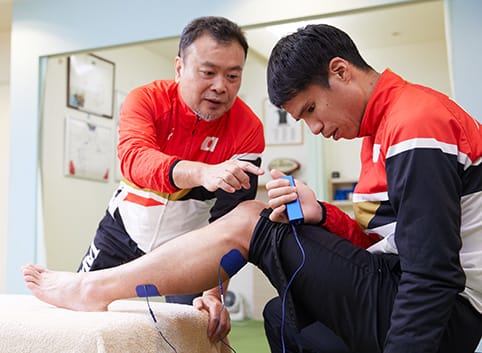
-
Horikoshi: Ooh… Maybe it depends where you stick the pads, but they feel really heavy. There’s a bit of an expansive feeling. I like that there’s no tingling. Is this Cool? Can I try the other modes? Wake is for a warmup, right? But what’s Act for?
Maeda: Act applies stimulation to the muscle, which makes you more aware of the part being stimulated. You can do Wake and Act one after the other, if you like.
Takamatsu: Like before a race?
- ITO: That’s right. Some people use it before competition or before the last call.
-
Maeda: It stimulates, or educates, the brain. It gives a learning effect.
Horikoshi: When you apply stimulation, you remember it.
I get it. So that’s what it is. I think I sort of understand it now. [laughs]
Looking Back on the 2021 Season
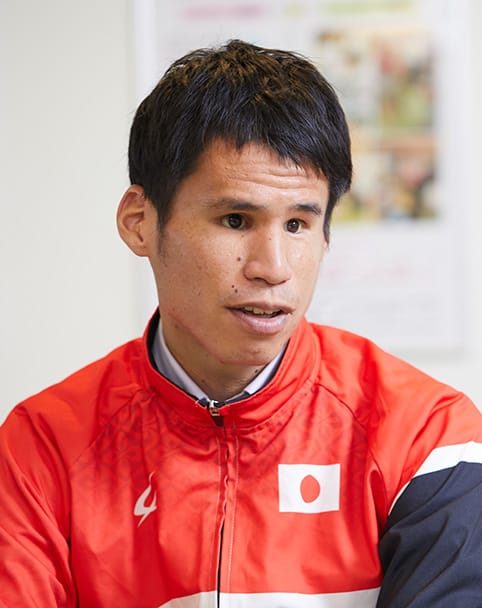
- ITO: Looking back on 2021, what were some of the challenges you faced?
-
Horikoshi: I won the Hofu Yomiuri Marathon in December of the previous year, setting an Asian record and significantly improving on my personal best. I thought I’d be in perfect shape going into 2021. And, sure enough, I beat my personal best in a half marathon in February and again in a 10 km time trial in April. I felt I was getting better, but in May, I injured my leg... I could hardly run at all in May.
I started running little by little again in June with a feeling of pain and managed to run without pain in July, but to be honest, I felt a bit “Hmm ...” [laughs] because I’d been planning to build a solid foundation for competition in summer over three to four months.
- ITO: What kind of treatment did you get?
-
Horikoshi: The trainer provided me with various types of guidance during our training camp. Other than that, I received treatment for the symptoms. After the application of ultrasound, the pain eased up and I was able to run. So I applied ultrasound before going out to practice, and afterwards I applied it some more.
I was stuck in isolation from June until the end of the competition, so I had to bring in the device myself, but it really saved my life. I feel the device helped me win the medal this time.
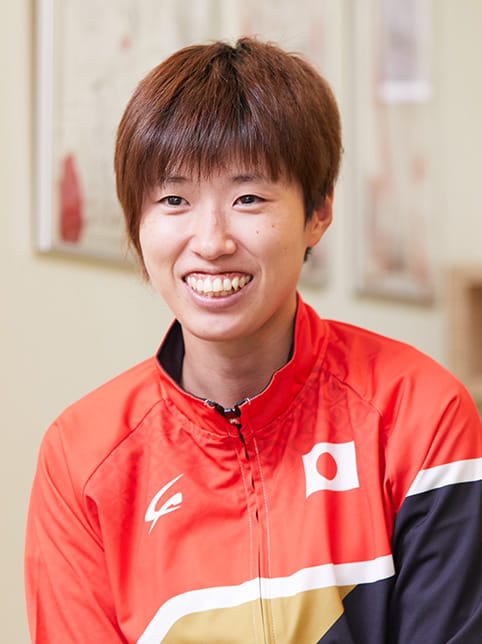
- ITO: Ms. Takamatsu, you really shone in both the relay and individual events.
-
Takamatsu: We were in the same group as the US and France in the qualifier for the universal relay, and I was trying desperately not to lose to the French as I made my touch. I was really nervous. I’m glad our team recorded a new best and advanced to the final.
I was the third runner, so I had to bend down to touch wheelchair-racer Tomoki Suzuki, who was the fourth. But in the final I was in lane one, so I couldn’t see his wheelchair, and I was really scared to touch him.
- ITO: How did you feel when he crossed the finish line in third place?
-
Takamatsu: More than anything I was tired. [laughs] Because I’d run three races that day: the 400 m qualifier, the relay qualifier, and the final.
I’d also injured my leg just before the Games, but I managed to run after getting a full course of acupuncture, massage, and ultrasound from the trainer.
-
Maeda: It wasn’t a pull or a tear, but I was worried. I applied tape, gave a lymphatic massage, and stretched the muscles. I didn’t want to make her anxious, so I kept saying, “It’s going to be okay! It’s okay, it’s okay!” [laughs]
And as a result...Takamatsu: I ran three races. [laughs]
Maeda: I was also happy with the result because I was worried about her leg.
Takamatsu really brightened up the atmosphere in the team. Even right before a race, she would come up to me and talk about something trivial—it gave me a little timeout, so I was really happy with her result.I was watching Horikoshi’s race from around the 40 km mark. I saw a look on his face I’d never seen before. I could tell he was determined to win the race. I couldn’t help shouting, “Go, go, go!”
We’ve been friends for more than 10 years. We’ve experienced the good times and the bad times together, so when he crossed the finish line, I was so overcome with emotion that tears welled up in my eyes.
Toward the Development of Parasports
- ITO: Lastly, please tell us about your future goals and dreams.
-
Takamatsu: I want to set new personal bests in the 400 m and 200 m first, with an eye on the next World Championships and three years from now.
Horikoshi: We’ll have races that count in the selection process starting next year, so my goal is to work hard for three years so I can stand on the podium again. And to that end, I’d also like to set a world record by running a marathon in under 2 hours and 20 minutes. If I can do that, I can proudly say, “I’m fast.” I think that would also ignite interest in parasports.
People tend to have a negative image of disabilities. I’d like to change that image into a positive one by getting as many people as possible to see me run.On top of that, I’d like to grow into an athlete who can be a role model for younger athletes, an athlete respected not just for their records, but as a human being.
Since so many people have helped me get to this point, I want to run with a sense of giving something back.Maeda: I’ve been a sports trainer for 30 years now. I’ve learned a great deal from parasports. I’d like to be the kind of therapist who can share my experiences with people with disabilities and intractable diseases. Together we can reflect on what they can achieve using their remaining abilities to help them live with a sense of purpose.
Horikoshi talked about “giving back.” I, too, would like to give back to parasports and to the para athletes who’ve given me courage and inspiration. I hope I can support them in their efforts to contribute to society.
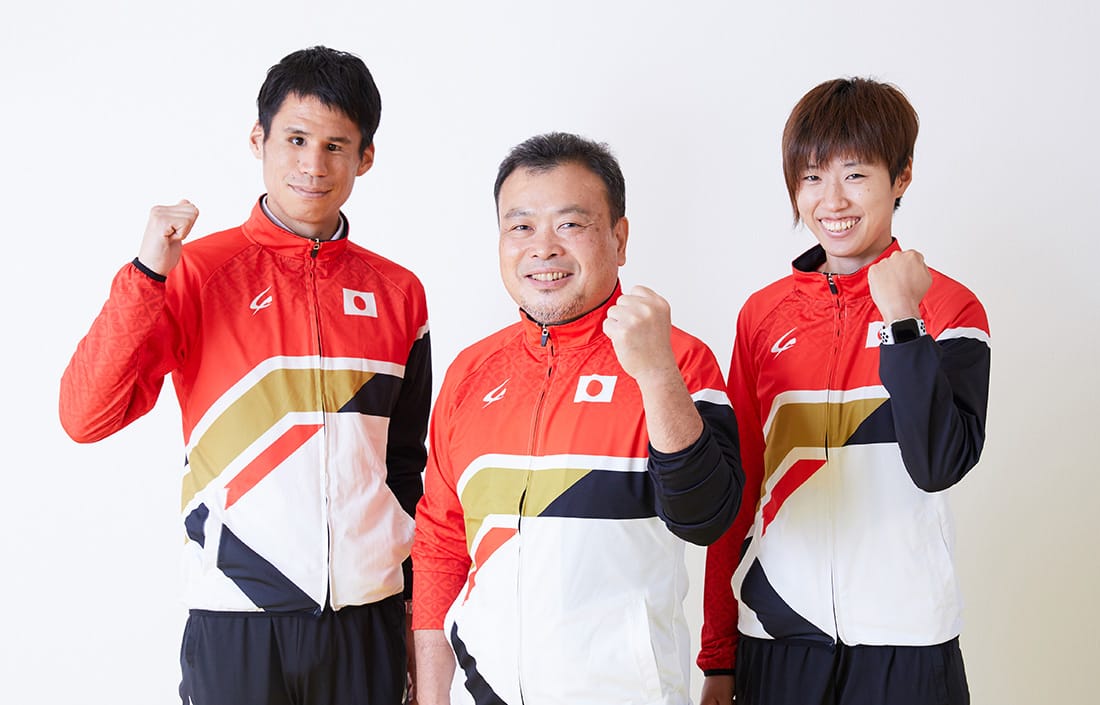
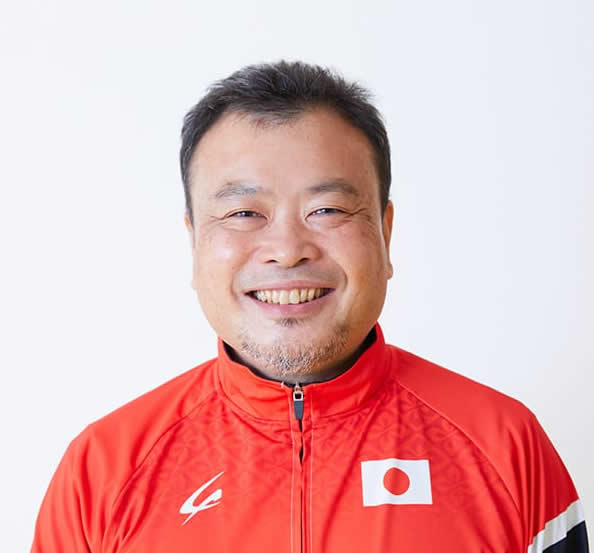
Representative of Maeda Chinese Medicine Research Institute Group. Director, Maeda Acupuncture and Osteopathy Clinic/Ginza Acupuncture Clinic. Member of the Trainer Subcommittee of the Japan Para Athletics Strengthening Committee.
After graduating from university, he completed an acupuncture course at Tokyo Eisei Gakuen College and a judo therapy course at Kuritake Gakuen’s Tokyo Therapeutic Institute . He enrolled in the Anatomy and Neuroscience course at Osaka University Graduate School of Medicine and pursued research in neuroscience.
He is a certified instructor and doctor patroller for the Ski Association of Japan and has also taught skiing to people with disabilities for 20 years at an Osaka City-run ski school for persons with disabilities.
He is currently pursuing research on the combination of acupuncture and exercise therapy for children and adults with disabilities and intractable diseases.
Career: Sanyo Electric Badminton Club (1996-2002) / Osaka Toin High School Baseball Club (1996-2012) / Adult Rugby: Kintetsu Liners (1998-2006) / Osaka Prefectural Police Rugby Club (2007-2017)
Among many other roles, he worked as a trainer for the Japanese Para Athletics Team at the London Paralympic Games (2012), Rio de Janeiro Paralympic Games (2016), and Tokyo 2020 Paralympic Games (2021).
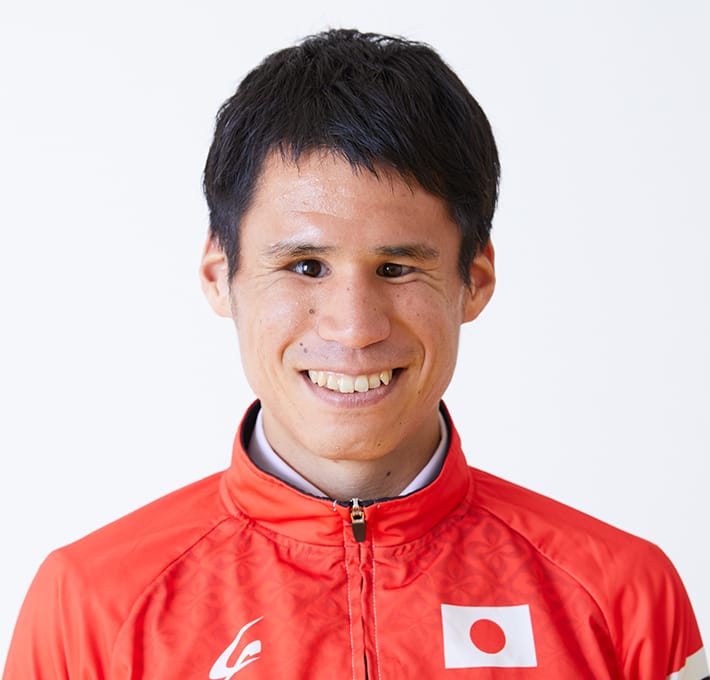
Born on July 19, 1989. From Nagano Prefecture. Member of the NTT West Athletics Club.
He began pursuing athletics after entering junior high school. In 2008 in Beijing, he represented Japan in the 5,000 m and 1,500 m at the Paralympic Games for the first time. He won a silver medal in the 5,000 m at the 2010 Asian Para Games in Guangzhou; finished in fifth place in the 5,000 m at the 2012 London Paralympic Games; and won gold medals in the 5,000 m and 1,500 m at the 2014 Asian Para Games in Incheon. He then shifted his focus to the marathon, finishing fourth at the Rio de Janeiro Paralympics. In the Tokyo 2020 Paralympic Games, his fourth consecutive Paralympic appearance, he won a long coveted bronze medal.
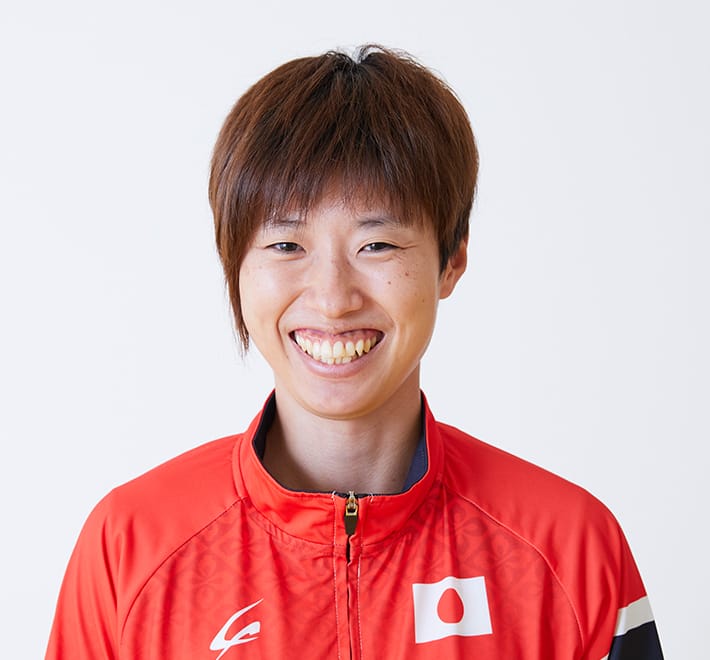
Born on May 31, 1993. From Osaka Prefecture. Employee of Lawson, Inc.
She started athletics at the suggestion of her mother in her second year of junior high school. As one of the best sprinters in the T38 class, she won Japanese records in three short-distance events (100 m, 200 m, and 400 m). At the 2016 Paralympic Games in Rio de Janeiro, she competed in two events, the 100 m and 400 m, placing seventh in the 400 m. The following year, she won a silver medal in the 400 m at the World Para Athletics Championships London 2017. At the Tokyo 2020 Paralympics, in addition to the three short-distance events, she competed in the universal relay, where she made a significant contribution to Japan’s bronze medal success as the third runner.
